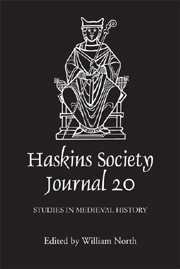Book contents
- Frontmatter
- Contents
- Editor's Note
- Abbreviations
- 1 Buckets, Monasteries, and Crannógs: Material Culture and the Rewriting of Early Medieval British History
- 2 Punishing Bodies and Saving Souls: Capital and Corporal Punishment in Late Anglo-Saxon England
- 3 Writing Latin History for a Lay Audience c. 1000: Dudo of Saint Quentin at the Norman Court
- 4 Between Neighbors and Saints: Waleran I of Meulan and the Allegiance of Lesser Lords in the Eleventh Century
- 5 Who Founded Durtal? Reconsidering the Evidence
- 6 Robert Curthose: Ineffectual Duke or Victim of Spin
- 7 The Chivalric Transformation and the Origins of Tournament as seen through Norman Chroniclers
- 8 An Internal Frontier? The Relationship between Mainland Southern Italy and Sicily in the ‘Norman’ Kingdom
- 9 ‘Hywel in the World’
- 10 Prices, Price Controls, and Market Forces in England under Edward I c. 1294–1307
2 - Punishing Bodies and Saving Souls: Capital and Corporal Punishment in Late Anglo-Saxon England
Published online by Cambridge University Press: 12 September 2012
- Frontmatter
- Contents
- Editor's Note
- Abbreviations
- 1 Buckets, Monasteries, and Crannógs: Material Culture and the Rewriting of Early Medieval British History
- 2 Punishing Bodies and Saving Souls: Capital and Corporal Punishment in Late Anglo-Saxon England
- 3 Writing Latin History for a Lay Audience c. 1000: Dudo of Saint Quentin at the Norman Court
- 4 Between Neighbors and Saints: Waleran I of Meulan and the Allegiance of Lesser Lords in the Eleventh Century
- 5 Who Founded Durtal? Reconsidering the Evidence
- 6 Robert Curthose: Ineffectual Duke or Victim of Spin
- 7 The Chivalric Transformation and the Origins of Tournament as seen through Norman Chroniclers
- 8 An Internal Frontier? The Relationship between Mainland Southern Italy and Sicily in the ‘Norman’ Kingdom
- 9 ‘Hywel in the World’
- 10 Prices, Price Controls, and Market Forces in England under Edward I c. 1294–1307
Summary
The Anglo-Saxon cemetery at Sutton Hoo is renowned for its prestigious seventh-century pagan burials, many of which were marked by mounds and accompanied by rich grave goods. In the centuries after the cemetery was founded, however, the site was given over to another purpose: the execution and burial of criminals. While a number of these executions may have occurred in the generations immediately following the high status burials, judicial sentences continued to be carried out at Sutton Hoo through the eleventh century, with the prevalence of decapitated, mutilated, and shamefully buried bodies attesting to the increasing punitive powers of English kings. The continuous use of an ostentatiously pagan site by later, Christian Anglo-Saxons suggests that it was no arbitrary decision to inter capital offenders at Sutton Hoo. Rather, this deliberate placement was intended to isolate the bodies of the condemned in a liminal area replete with heathen associations – an area conspicuously removed from the holy ground in which the pious were buried. The site's prominent pre-Christian monuments would have provided a visually striking inversion of burial ad sanctos, and the association of mounds with demons and spirits of the heathen damned during the late Anglo-Saxon period would have implied that those buried in such a place were unworthy of Christian salvation. While a virtuous Christian would be buried in hallowed ground, near the relics of saints and surrounded by prayers of the pious, an executed offender would be buried among heathens, beyond the Church's jurisdiction, where no prayers would be offered to help rescue his soul from hell.
- Type
- Chapter
- Information
- The Haskins Society Journal 202008 - Studies in Medieval History, pp. 39 - 57Publisher: Boydell & BrewerPrint publication year: 2009

